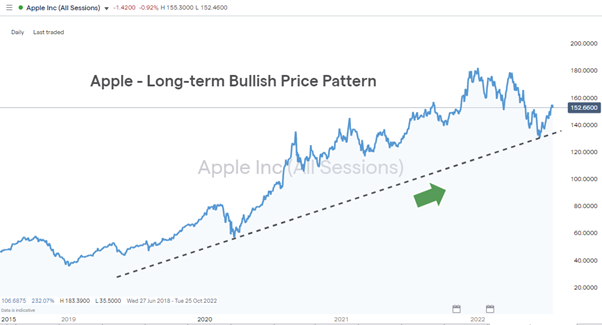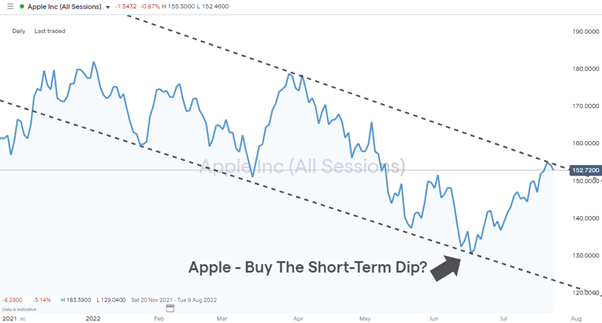
Deciding to invest in stocks is so easy that random stock picks made years ago would have resulted in impressive returns. The even better news is that if you use the correct analysis methods, you can optimise the returns on your long-term investments. We consider below the different types of analysis investors use, each designed to determine the potential risks and advantages of long-term investments in the stock markets. But what are the best Analysis Tools for Long Term Investments?
Each method of analysis is used for its own set of circumstances and has its pros and cons. Some might be more of a natural fit for your way of trading, but we'll also look at ways to combine the different approaches. That can result in a well-rounded strategy which is the best fit for meeting your investment aims.
FUNDAMENTAL ANALYSIS
Whether you're seeking information about a company, a stock, or the entire market, fundamental analysis is a common choice for traders preparing to make long-term investment decisions. Through this method of studying a company or market, investors can evaluate the extent of a security's value and how it will affect their investment actions. This method compares tangible assets such as land and buildings with intangible assets such as trademarks and branding.
Fundamental analysis incorporates the past performance of single stocks, industrial sectors, and the broader economy. Macro themes can also be incorporated. If you're anticipating an economic downturn, you might want to consider buying stocks during a recession. If inflationary pressures are your primary concern, then tips on how to invest during times of high inflation are worth considering.
When using fundamental analysis, it's possible to zoom in and, for example, carry out in-depth research on a particular stock; or zoom out and consider how geopolitical uncertainty between countries could influence a stock's valuation.
Fundamental analysis allows investors to consider past performance and hypothesise about future trends. You might, for example, believe that the move towards clean energy will result in a short-term boom in mining stocks. All those EV charging points and public transport infrastructure will need to be built out of materials miners such as Rio Tinto dig out of the ground.
Of the different types of analysis, fundamental analysis is the one which incorporates the greatest degree of thinking on where stock prices might be going rather than where they have been.
Pros
- Converts tangible themes, such as inflation, consumer spending, and unemployment levels into trading ideas
- Allows investors to take a view on a firm's growth prospects and whether or not new initiatives will be successful
- Can be applied to any stock and any sector. Ranging from defensive stocks and high-yield income stocks to growth stocks and small-cap pharma investments
Cons
- Helps establish what to buy, rather than when to buy it
- Economic predictions can be way off the mark, and markets and share prices can change dramatically in the space of months, if not weeks
TECHNICAL ANALYSIS
Technical analysis uses historical data, mainly relating to price, to determine whether stocks are currently undervalued or overvalued. Other metrics include trade volumes, and the greater the amount of trading during a particular time, the stronger the ‘signal'.
It also uses ‘charting' techniques, allowing investors to plot and spot trends and to identify when price diverges from its long-term trajectory or presents a buying opportunity.
One key difference between technical and fundamental analysis is that the technical approach incorporates a range of different time periods. A price chart of a stock which covers the last few months might point to the price trend being downward. At the same time, extending the timeframe to several years could point to the current price weakness being a temporary blip and a dip to buy.
Apple Share Price Chart 2018 – 22 – Long-term Bullish Price Action

Source: IG
Long-term investors will obviously benefit from using the long-term metrics rather than the short-term ones. But if you're looking to optimise the time of your entry into a position, then short-term technical indicators can be ideal tools.
Apple Share Price Chart – 2022 – Short-term Bearish Price Action

Source: IG
Some technical analysis indicators are ‘stronger' than others, so understanding the basics can help you find the best one to use. It's also prudent to try and use different indicators in conjunction with each other. If, for example, your RSI, VWAP, and momentum indicators point to a stock being a buy, then that's a stronger confirmation than if one is not in line.
Pros
- Technical analysis is an ideal tool for identifying when to trade
- Markets aren't as efficient as many would like to think they are. Price can, in the short-term, overshoot to the upside or downside, and trading in and out of positions at those times can enhance returns
Cons
- As it uses historical data, technical analysis is, by definition, backwards looking
- Technical analysis does not factor in macro themes such as geopolitical risk, wars, or recessions
QUANTITATIVE ANALYSIS
Quantitative analysis studies the history of a company or market conditions and performances to gain insight. There are two methods used in this form of analysis. The first is calculations based on earnings per share (EPS), which is a simpler approach. The second is more complicated and works with calculations like discounted cash flow (DCF).
This form of analysis gets to the heart of stock valuation techniques which use projected future earnings as the main determinant of what is currently a fair price for a stock. The reports provided by firms relating to their performance are detailed and transparent. As part of their compliance, reporting firms need to ensure they are also accurate – so investors can draw their own conclusions on whether a stock is a buy.
Quant analysis of stocks can be used to provide an absolute or relative valuation. In both instances, data relating to critical metrics, such as earnings or operating margins, is incorporated into a model. Each metric is ‘weighted', and a number is produced.
Models which use data to generate ratings can offer a ‘cleaner' outcome. It's possible to compare one stock to another, with the only subjective element of the process being how the weighting is determined and what metrics are to be used. Then all of the stocks go through the same modelling process.
One disadvantage of the approach is that underlying differences between firms might be nuanced and not detectable by number-crunching. They also struggle to incorporate forward-looking factors such as plans by a firm to expand into a new market in the future.
Year-end and quarterly earnings reports are a time of excitement for stock investors as they are when the latest quantitative information is shared. For this reason, the period after earnings updates have been released can be moments when new trends form, and those are just what long-term stock investors need to be part of to maximise their returns.
Pros
- A model which generates a single number offers a ‘clean' and streamlined way to filter down a large population of stocks down to a more manageable short-list
- The process is designed to make the process as objective as possible and to limit scope for human error or biases that cloud the picture
Cons
- Comparisons across sectors can be challenging to make. Tech stocks, high-dividend utility stocks, and green energy stocks, for example, have very different business models. Using the same model to analyse stocks from different sectors can be similar to comparing oranges and apples
- Sometimes human intervention can complement the data-crunching nature of quant analysis
- A stock may be the best in its sector but is likely to underperform even the weakest stocks in another sector
Personal Research
It's important not to underestimate the power of your research. It can be as simple as noticing a retailer you visit is seeing greater footfall thanks to its recent product lines being popular. That kind of data won't feed through into a firm's financial reports for weeks or months, so investing on the back of your own experiences can help you get ahead of the crowd.
Investing in firms you know well can allow you to spot potential positive and negative trends and form part of your day-to-day activities. That can reduce the time required reading written reports and third-party research.
Pros
- The information you use to make your decision will be up to date
- If you as a consumer have a view on a firm, then it's possible to expand that into a view taken as an investor
Cons
- Noticing one part of a firm is performing well is helpful, but the share price will be determined by a range of other factors you may not be aware of
- Good news can take some time to filter into the market, which means you might have to sit out short-term fluctuations before the rest of the market notices the buy signals you did
Using Different Types Of Stock Analysis In Conjunction
The risks and benefits found through this analysis make decisions clearer and opportunities easier to recognise. It is also vital to remember that as the stock market (or any relevant market) changes, the analysis should be reviewed to stay updated. The best long-term investment strategy will combine these four methods of analysis to produce an informed and diverse approach.
Fundamental, quantitative, and personal research can be valuable tools when trying to identify and filter potential targets. Each can offer a double-check of the other, but if they are aligned, you're probably onto a good thing. Rushing into the market is one option, but applying technical analysis and patience can help you optimise trade entry points and enter into trades at lower levels.
Things to Consider When Investing In Stocks For The Long-Term
Picking the right stocks is the first part of successful trading; however, to optimise returns, there are a few tricks to use to minimise the ongoing costs associated with trading.
Good brokers such as those found on this short-list offer competitive T&Cs, which means putting the trade on in the first place won't result in it being massively underwater from day one. Some brokers also provide commission-free trading either as standard practice or as part of occasional promotional offers.
It is also essential for long-term investors to ensure they use the share dealing rather than the CFD trading service. Most good brokers offer both, and while CFDs come with some neat features such as leverage, they also incur daily financing charges. On the other hand, buying stocks outright is more cost-efficient as once the deal is done, ongoing administration costs are minimal.
If you're looking to invest in a particular market, such as commodities or green energy, then stocks can be an ideal way to get cut prices in those sectors. There's no need to buy copper or carbon futures when companies which operate in the sector offer a convenient share dealing based method of accessing the market.
Final Thoughts
Whether you are an experienced investor or new to trading, investing in stocks can be a user-friendly way to make your money work harder for you. Whichever approach you take towards analysing stocks for the long run, much of the research is done upfront. There's obviously a need to monitor events, but buy-and-hold investors can, on the whole, take a more relaxed approach and watch the value of their portfolio grow.
If you're concerned that after monitoring prices for years you might go to withdraw your money and find you've been a victim of a scam, then making sure your broker is legit is something else to consider. This list of trusted brokers includes firms reviewed by the AskTraders team and checked in terms of the security and other services they offer their clients.




